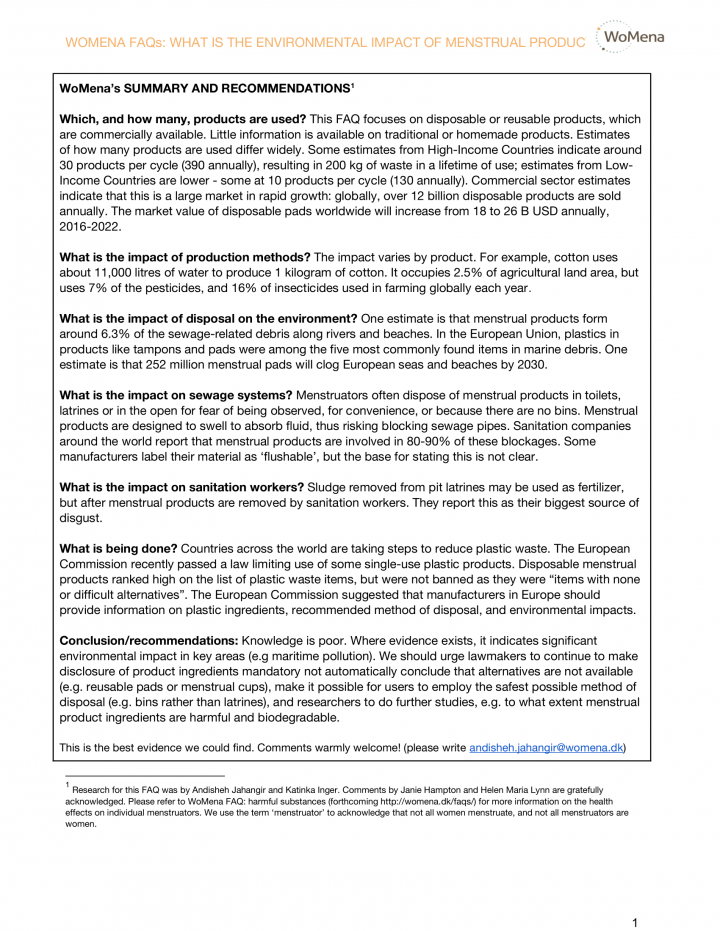WoMena FAQ: What is the environmental impact of menstrual products? WoMena (2019)
WoMena’s SUMMARY AND RECOMMENDATIONS
Which, and how many, products are used?
This FAQ focuses on disposable or reusable products, which are commercially available. Little information is available on traditional or homemade products. Estimates of how many products are used differ widely. Some estimates from High-Income Countries indicate around 30 products per cycle (390 annually), resulting in 200 kg of waste in a lifetime of use; estimates from Low-Income Countries are lower - some at 10 products per cycle (130 annually). Commercial sector estimates indicate that this is a large market in rapid growth: globally, over 12 billion disposable products are sold annually. The market value of disposable pads worldwide will increase from 18 to 26 B USD annually, 2016-2022.
What is the impact of production methods?
The impact varies by product. For example, cotton uses about 11,000 litres of water to produce 1 kilogram of cotton. It occupies 2.5% of agricultural land area, but uses 7% of the pesticides, and 16% of insecticides used in farming globally each year.
What is the impact of disposal on the environment?
One estimate is that menstrual products form around 6.3% of the sewage-related debris along rivers and beaches. In the European Union, plastics in products like tampons and pads were among the five most commonly found items in marine debris. One estimate is that 252 million menstrual pads will clog European seas and beaches by 2030.
What is the impact on sewage systems?
Menstruators often dispose of menstrual products in toilets, latrines or in the open for fear of being observed, for convenience, or because there are no bins. Menstrual products are designed to swell to absorb fluid, thus risking blocking sewage pipes. Sanitation companies around the world report that menstrual products are involved in 80-90% of these blockages. Some manufacturers label their material as ‘flushable’, but the base for stating this is not clear.
What is the impact on sanitation workers?
Sludge removed from pit latrines may be used as fertilizer, but after menstrual products are removed by sanitation workers. They report this as their biggest source of disgust.
What is being done?
Countries across the world are taking steps to reduce plastic waste. The European Commission recently passed a law limiting use of some single-use plastic products. Disposable menstrual products ranked high on the list of plastic waste items, but were not banned as they were “items with none or difficult alternatives”. The European Commission suggested that manufacturers in Europe should provide information on plastic ingredients, recommended method of disposal, and environmental impacts.
Conclusion/recommendations:
Knowledge is poor. Where evidence exists, it indicates significant environmental impact in key areas (e.g maritime pollution). We should urge lawmakers to continue to make disclosure of product ingredients mandatory not automatically conclude that alternatives are not available (e.g. reusable pads or menstrual cups), make it possible for users to employ the safest possible method of disposal (e.g. bins rather than latrines), and researchers to do further studies, e.g. to what extent menstrual product ingredients are harmful and biodegradable.
Bibliographic information
WoMena (2019). WoMena FAQ: What is the environmental impact of menstrual products? WoMena
Filter / Tags
EnglishMenstrual Health and Hygiene (MHH)
External links
Downloads
WoMena FAQ: What is the environmental impact of menstrual products?
Type: application/pdf
Size: 0.58 MB

